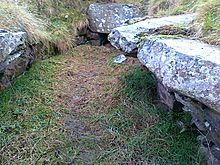|
|
|
|
LynchatSouterrain
|
||||||||||||||||||||||||
|
|
|
News |
|
|
Work on A9 leads to 'Iron Age finds' in Cairngorms Work on the A9 has led to the discovery of a possible structure, pottery and a stone tool from the Iron Age. http://www.bbc.co.uk/news/uk-scotland-highlands-islands-42227561 |
4th December 2017ce |
Images (click to view fullsize) |
|




|
Fieldnotes |
|
|
Next to Brochs souterrains are pretty cool (in both meanings of the word) and this one, as Rhiannon suggests is superb. We had been trying to get around to a visit for a couple of years and as the photos suggest we managed to take a peek. I believe it is possible to walk from Kingussie but we took the lazy option and took the farm track off the A9 and parked at a place suggested by the homemade P for parking sign. It’s a short walk following the track and across a field to the site. The souterrain is much as described, crescent shaped and quite large. Unfortunately the middle section has collapsed and been robbed away, a shame but this does permit a closer examination of the construction method. At the time of our visit (November) the backdrop to the site was a snow covered Cairngorm, this site is well worth a look. |
Posted by broch the badger 11th November 2013ce |
Folklore |
|
|
The Cave Of Raitts, a little way off the main road near Lynchat, is a horseshoe-shaped and roofed with large slabs of stone, and is sometimes claimed to be an Old Pechts (Picts) House. The semi-subterranean low-roofed souterrains or earth-houses, probably once used for storage, are often popularly identified as having belonged to the Pechts or Picts, sometimes equated with fairies. The structure may look low from the outside, but as its other name An Uaimh Mhor (The Great Cave) implies, it is actually quite ample, and another tradition more suitable to its size is that it was built by giants. According to Alexander MacBain, writing in 1922: The women carried the excavated stuff in their aprons and threw it in the Spey, while the men brought the stones, large and small, on their shoulders from neighbouring hills. All was finished by morning, and the inhabitants knew not what had taken place. The Lore Of Scotland - A Guide To Scottish Legends Westwood & Kingshill |
13th January 2024ce Edited 14th January 2024ce |
|
This typed compilation of information about the souterrain comes from the Highland HER. It seems that the names of the clans responsible for bad behaviour / revenge are fairly loose. I guess it depends on the ancestry of who's telling the tale. An excerpt from a booklet written in the 1970s says: The cave [..] is thought to have formed a refuge for persecuted worshippers at various times in its history. There is also an old legend that it was built by giants while giantesses carried the soil to the River Spey in their aprons.Again there's the curious assertion that the cave was only discovered in the Victorian era, yet it's simultaneously stated it was used after the Jacobite rising of 1745! Remember, things do not really exist until a Victorian man belonging to an Intellectual Society has looked at things Properly. |
 Posted by Rhiannon
Posted by Rhiannon15th May 2013ce Edited 15th May 2013ce |
The photos on the Megalithic Portal suggest this place is rather superb. Far from being discovered in 1835 (as the Canmore record suggests), this souterrain must surely have been known for long before that? The story is a bit wordy but bear with me.In the time of the later Jameses, a noted freebooter of the name of Cumming, with his eleven sons, was the scourge of Strathspey and the more distant glens of Perthshire, and long baffled the feeble efforts of the law.To save you from the waffling, I'll summarise. The murderous Cummings finally wound up a Macpherson enough that he vowed to rumble them. He pretends to be a gravely ill beggar to gain admittance to the bothy (it's not explained how he actually knows about the bothy). He notices the old women are baking far more bannocks than they can eat and realises they're being transferred to the cave below. He dashes to Perth to call the authorities. The authorities haul them out one at a time and don't even bother with a trial, they just despatch them there and then. Which seems rather unfair. But there is an afterword: This is the story told by tradition, and I give it without attempting to prove its truth. I have, however, visited the cave; and the story was told to me as I sat within the dark, grave-like, chamber.Reported by J.C.P. in The Scottish Journal in 1847. |
 Posted by Rhiannon
Posted by Rhiannon14th May 2013ce Edited 14th May 2013ce |

